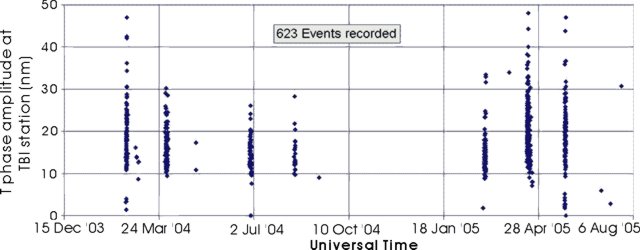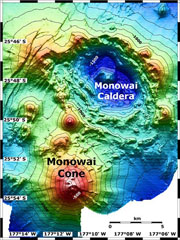Report on Monowai (New Zealand) — July 2005
Bulletin of the Global Volcanism Network, vol. 30, no. 7 (July 2005)
Managing Editor: Edward Venzke.
Monowai (New Zealand) Activity revealed by T phase swarms in 2004 and 2005
Please cite this report as:
Global Volcanism Program, 2005. Report on Monowai (New Zealand) (Venzke, E., ed.). Bulletin of the Global Volcanism Network, 30:7. Smithsonian Institution. https://doi.org/10.5479/si.GVP.BGVN200507-242050
Monowai
New Zealand
25.887°S, 177.188°W; summit elev. -132 m
All times are local (unless otherwise noted)
Monowai is a frequently active submarine volcano; during April-November 2003, eleven earthquake and T phase swarms from Monowai were recorded by the Polynesian seismic network (Réseau Sismique Polynésien, RSP) operated by the Laboratoire de Geophysique (LDG) (BGVN 28:11). Approximately 260 T phases in 2004 and 365 in January-August 2005 were detected and analyzed by LDG.
In 2004, four short swarms, of 2-3 days duration and 50-80 T phases per swarm (figure 16), occurred on 18-19 February, 31 March-2 April, 27-29 June, and 14 August. Between August 2004 and March 2005, no T phases from Monowai were recorded, indicating a period of quiescence at the volcano. In 2005, T phase swarms from Monowai were recorded on 2-3 March, 16-21 April, and 25-26 May.
 |
Figure 16. Amplitudes of T phases originating from Monowai Seamount recorded at TBI station on Austral Island (see map in BGVN 28:02), versus time. Courtesy of D. Reymond and O. Hyvernaud, LDG. |
As of early August 2005, volcanic activity, as indicated by T phases recorded by RSP, resumed, though numerous events have not yet been analyzed.
Geological Summary. Monowai, also known as Orion seamount, is a basaltic stratovolcano that rises from a depth of about 1,500 to within 100 m of the ocean surface about halfway between the Kermadec and Tonga island groups, at the southern end of the Tonga Ridge. Small cones occur on the N and W flanks, and an 8.5 x 11 km submarine caldera with a depth of more than 1,500 m lies to the NNE. Numerous eruptions have been identified using submarine acoustic signals since it was first recognized as a volcano in 1977. A shoal that had been reported in 1944 may have been a pumice raft or water disturbance due to degassing. Surface observations have included water discoloration, vigorous gas bubbling, and areas of upwelling water, sometimes accompanied by rumbling noises. It was named for one of the New Zealand Navy bathymetric survey ships that documented its morphology.
Information Contacts: Dominique Reymond and Olivier Hyvernaud, Laboratoire de Geophysique, CEA/DASE/LDG Tahiti, PO Box 640, Papeete, French Polynesia.

